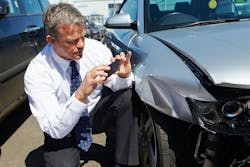On Monday, Oct. 2, 2017, a Texas juror stood up and delivered an unsurprising verdict: John Eagle Collision Center was guilty of incorrectly repairing a 2010 Honda Fit that, after experiencing a subsequent crash, trapped Matthew and Marcia Seebachan from the inside as it burned. John Eagle’s staff failed to properly follow OEM procedures, and instead used untested adhesive to replace a hail-damaged steel roof.
The narrative that unfolded from that horrific event sounded familiar to many shop owners: Todd Tracy, the Seebachans’ lawyer, also alleged that State Farm “forced” John Eagle to defer from an OEM-mandated repair. Regardless of whose fault it was, suddenly, the consequences of not following OEM procedures had a number—a big number—attached to it: $42 million.
The verdict—a watershed moment for collision repair—capped off a year that, up to that point, had seen vast change occur in the shop-insurer dynamic, stemming from myriad lawsuits and new initiatives from insurance companies to overcome huge underwriting losses.
As vehicles become automated and technology warps the auto insurance landscape, body shops are experiencing the after effects and being forced to re-adjust, says Joe Schneider. As managing director for KPMG Corporate Finance, Schneider co-leads the firm’s extensive evaluation of the quickly changing insurance industry—and one truth has become incredibly clear:
“The [insurance] industry hasn't made money off this line of business for years, and lots of the technology and underlying systems supporting the businesses are not state of the art. So if they're having trouble underwriting profitable insurance business, what is going to happen when we enter into the chaotic middle,” he says.
The chaotic middle—a period of uncertainty following what was a stressful year for auto insurance profits. As 2018 unfolds, Schneider says that uncertainty will gain shape and crystallize into what, moving forward, will become the norm for shop-insurer relations.
So, as a shop owner, you need to know everything warping the traditional understanding of that relationship. This article details two of those major industry changes: following OEM procedures and handling virtual claims.
Additionally, check out how two shop owners entrenched in the shop-insurer battle plan to adjust to those changes.
Following OEM Procedures
Before you can understand the future prospects of OEM procedures, Schneider says to think of them less as “cars,” and more as “supercomputers on wheels.”
“Before [insurance companies were] managing drivers. Now, it's about insuring technology and algorithms that will be operators of the vehicles,” he says. “In this space, there will be insurers that have difficulties. There's a large disparity of information and data that OEMs have, versus what the insurers have.”
And the insurers will need that information if they’re going to survive, Schneider says. Whereas the OEMs were once an ancillary presence to the shop-insurer relationship, they are increasingly becoming directly involved with the transaction.
“If you take your car in Tuesday night, then you get an over-the-air update, and on Wednesday morning, it’s running a different software, guess what? That's a different risk profile. That has insurance repercussions,” Schneider says. “Given that, [OEMs] are in unique position to understand the risk of the vehicle better than a third party.”
Thus, to succeed in the chaotic middle, insurance companies will need to be proactive and partner with automakers—and if that happens, OEM procedures go from a “recommendation” to an “obligation.”
But will OEMs want to partner with insurers? And if they do, will that change the claims process for shops?
There are a lot of maybes, Schneider says. But there are two likely scenarios for how it plays out:
OEM Insurance Divisions
For months, Ford has tested a vehicle subscription service available to drivers. Other companies—including Volvo, Mercedes, BMW, Porsche, Cadillac and Lincoln—are also in front of a growing trend where subscriptions bundle vehicle costs, such as maintenance and roadside assistance, into monthly payments.
Also included in those bundles is insurance coverage.
With OEMs looking to boost dealership profits, subscriptions seem like a natural next step to Schneider, since OEMs could then push work to dealer body shops—a practice commonly known as “steering” in the collision repair world.
But it’s not that simple, Stephanie Braun says.
“I have my doubts they’ll want to get into this in a big way,” says the director of auto product design at Esurance. “Insurance is hard.”
Braun is not alone in believing OEMs are reluctant to establish their own insurance divisions. The insurance industry, after all, is regulated by laws and insurance commissioners. Not only would steering be regulated as it currently is with insurance companies, but Schneider adds that insurance companies experience the burden of “trap capital.”
“Back in ‘09, with the bailouts, you had a situation where people were very focused on liquidity and the fungibility of capital,” he continues. “As soon as you own an insurance company, that capital is tied up. You can't just move your cash around as easily.”
The alternative is, then, to sell the data to the insurance company—on which is Esurance is banking.
Insurer-OEM Partnerships
As the director of auto product design at Esurance, Braun heads the company’s telematics program that’s currently established in 15 states (and counting). This program allows Esurance to track vehicles and log important driving details, like speed, hard braking, number of miles driven, and—as you might have already guessed—crashes.
This effort is largely fueled by Esurance’s app, DriveSense, which automatically detects a moving vehicle. Currently, the app cannot actively detect crashes, but that’s the goal. And if Esurance is able to secure OEM partnerships, its access to vehicle data will only increase its awareness of crashes and allow the company to quickly initiate the claims process with body shops.
Ultimately, Braun says, an OEM-insurer partnership would streamline the claims process and improve efficiency.
“The faster we get the person to the right body shop, the faster we recognize what’s wrong with the car, the easier it is for everybody,” she says.
Craig Edmonds concurs. As the vice president of claims at Esurance, he’s very interested in leveraging data from OEMs in order to triage vehicles to properly equipped shops. In effect, because of OEM partnership, data sharing with body shops will improve.
“Immediate communication of data, such as the type of loss and severity of damage, can facilitate parts ordering and provide customers faster cycle times,” Edmonds says. “Shops would need to utilize their management systems to share data and communicate with OEM’s and carriers to leverage the technology.”
Autonomous vehicle technology could shrink the auto insurance sector by 71 percent—or $137 billion—by 2050, according to a KPMG report, so it’s essential that insurers establish these partnerships with OEMs, Schneider says.
And while OEMs could form robust agreements and sell data to insurers, there are certain cases where it’s more profitable for an OEM to take on a particular claim, meaning a body shop could see claims process change on a case-by-case basis.
Handling Virtual Claims
On August 7, 2017, FenderBender reported on a growing trend: customers snapping photos of damaged vehicles. The poster child of the project was Allstate, which has an app called QuickFoto Claim that empowers drivers to fuel the growing wave of virtual claims.
Just three days after the publishing of that article, Allstate very quietly laid off 500 employees—casualties of, to quote Allstate directly, a “more efficient system” that replaces claims adjusters with that very app.
In that moment, virtual claims went from a fad to a clearer realization: Insurance companies are heading down this road, and collision repair shops need to be ready.
While many shop owners are wary about the particular change to this new procedure, Schneider says it’s important to step back and understand exactly why insurance companies are taking such drastic pivots with claims.
At KPMG, Schneider evaluates the insurance market daily, and, in particular, the staggering losses those companies have experienced because of auto insurance. Take State Farm, seemingly the most formidable juggernaut of the insurance industry, which saw its net worth rise $5 billion between 2016 and 2017—and also saw its annual profit on car insurance claims fall 94 percent. While the company experienced a $4.2 billion increase in the property-casualty units’ stock portfolio, the company’s underwriting loss widened from an already abysmal $4.2 billion to $7 billion between 2016 and 2017.
These sorts of losses are universal across the board for insurance companies, Schneider says, signaling why Allstate—which recorded $124 million in underwriting losses in 2016—spent $53 million restructuring its staff to focus more on photo claims.
So, once again: This is not a fad. Companies are investing heavily, and there are some major players involved:
CCC Information Services
In the collision repair industry, you’ve probably heard or seen the phrase “touchless claim.” In August 2017, Bill Brower, vice president of LexisNexis Risk Solutions, appeared on A.M. BestTV to discuss how, on average, three or more people touch the average claim—and insurance companies desperately want to reduce that number to zero.
David Bliss, however, doesn’t like that term. And as the senior director of product management for CCC Information Services, he asks himself: Is “touchless” the proper goal, here?
“We decided it wasn’t because a number of repair facilities and MSOs and also insurance carriers pride themselves on being high quality service providers,” he says. “‘Touchless’ seemed a bit mechanical and robotic. While some customers may prefer to interact with you digitally, you’re still touching them in the way that you want to be engaged.”
One of CCC’s early remedies for this was CCC Smart Total Loss, which is an artificial intelligence-powered claims solution that uses and analyzes photos to help insurers predict a vehicle total loss within seconds—without human intervention.
Now, Smart Total Loss is part of a larger suite of options—the CCC Smart Claims Suite—which, as a whole, aims to revolutionize the way claims are processed.
Bliss breaks down CCC’s approach into three components:
Driver-Generated Photos. First, consumers take photos of the vehicle damage. Then, a repair facility or insurance appraiser writes the estimate based on those photos.
As of now, this practice doesn’t represent a huge percentage of claims, “but the number is growing,” Bliss says, and “it will continue to gain adoption.”
AI-Powered Inspections and Estimates. “Why require a human to do all of the components of the inspection and estimate writing that could potentially be done more accurately in an automated fashion using computer vision and artificial intelligence?” Bliss posits. “So that’s sort of the second phase that we believe will happen. Certain capabilities could be automated through those technologies.”
Telematics-Enabled Claims. As more connected cars roll off the assembly line, more cars will have the ability to alert parties about accidents.
“They can do so already, not a huge number,” Bliss says, “but the newer ones that have an onboard device can tell us at CCC today that they’ve been in an accident. They can’t tell us what exactly needs to be fixed, but in the future, they will.”
This doesn’t necessarily include body damage, but any sensors or electronics that need to be fixed will be known before the car reaches the body shop.
Third Parties
While CCC is a behemoth in the collision repair industry that can greatly inspire change, Schneider says there are many third-party companies throwing their hats in the virtual claims arena. Because these third parties use photos of vehicle damage and converse with shop estimators over the phone, insurers can easily replace their appraiser staffs with these remote negotiators.
Snapsheet, in particular, interacted with thousands of shops last year, Schneider says, and has emerged as a leader in this arena.
“Anywhere a car could be located, we're able to capture photos of it and provide an estimate,” Snapsheet president CJ Przybyl says. “Then we have a team that will negotiate with supplements with shops.”
The Snapsheet model is no joke: Last year, the company performed 400,000 estimates (that’s over 1,000 estimates a day) with a staff of 53. Snapsheet represents 60 different insurance clients that have hired Snapsheet to follow their specific guidelines and perform negotiations on their behalves.
“We're seeing every single major insurance carrier has the initiative to something virtual,” Przybyl says. “Everyone has it on their 2018 roadmaps to figure it out.”
Przybyl has had to fight body shops from day one over using photo-produced estimates—and he understands that concern.
But Przybyl believes the judgment may be a bit clouded.
“Shops have been concerned it would stop people from driving to the shop to get a quote, in which case they would try to sell the repair,” Przybyl explains. “There’s a fear that less people will get cars repaired and it will impact business. What we've seen is that's not the case.”
Przybyl says there is no drop-off of customers, and, in fact, drivers receive their estimates more quickly. He claims that shops see the value of the service the more they engage with Snapsheet and work to make the claims process more efficient. As opposed to waiting hours, or perhaps days, for a field adjuster to visit the shop, Snapsheet’s remote adjusters work with estimators over the phone.
“They don't have to have estimators write an original estimate because they have one,” he says. “If they have a supplement, they don't even have to write the supplement. They'll provide the photos and we'll write the supplement and do the hard work for them.”
With experienced, licensed appraisers surveying vehicle photos, Przybyl claims it is no different than evaluating it in a live setting.
“If you drive into a body shop, aside from putting it up on a lift, the body shop is not tearing that car down at the time,” he says. “They're looking at it and making an assessment about if it's safe to drive. We do the same thing. We're on par with the insurance field staff in terms of accuracy.”


